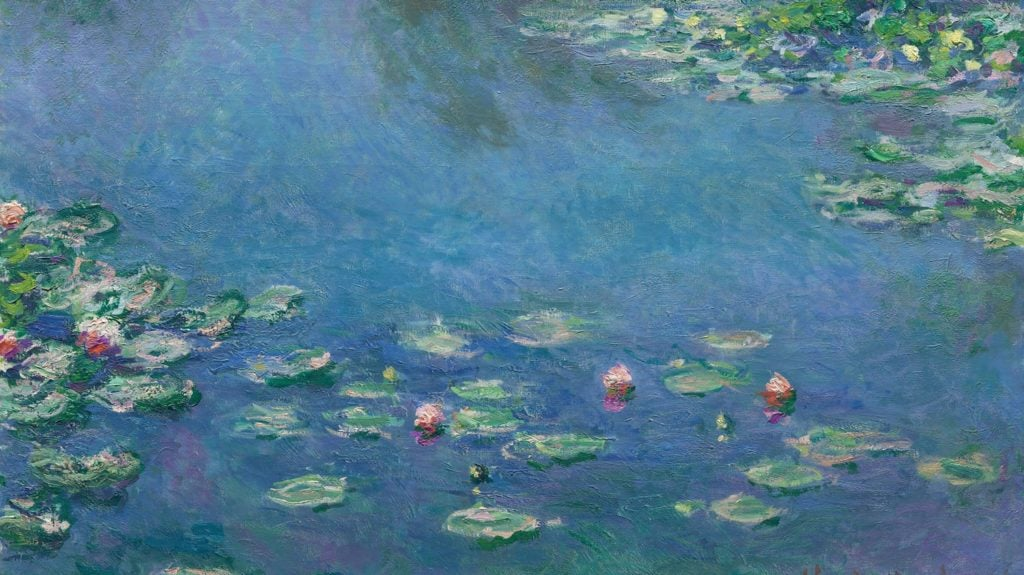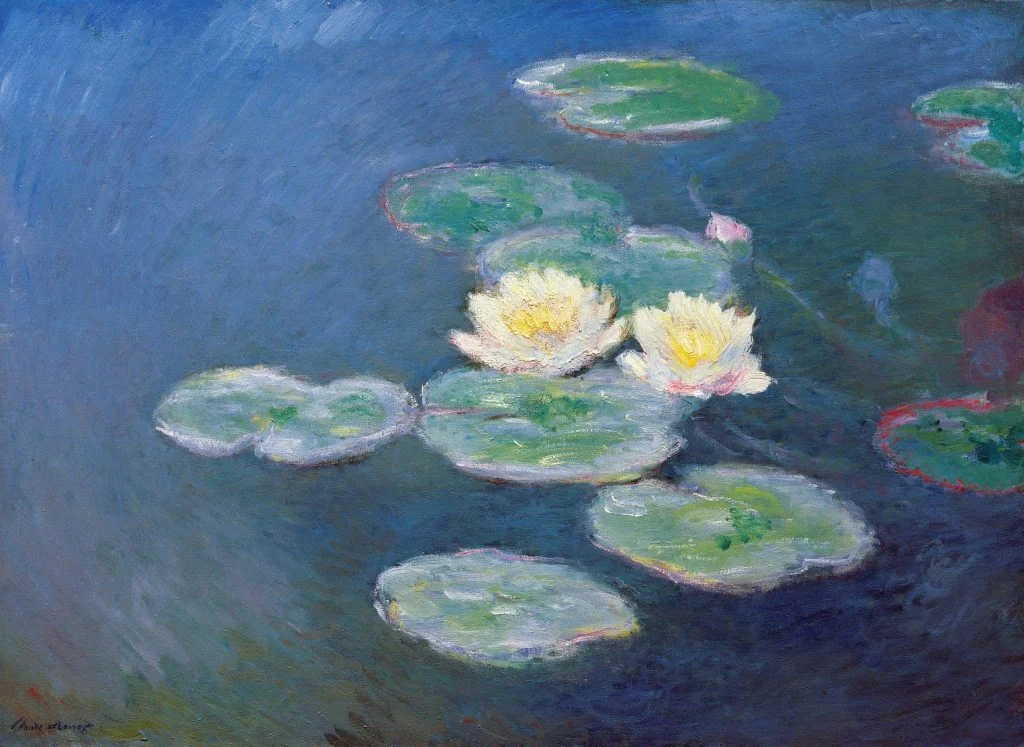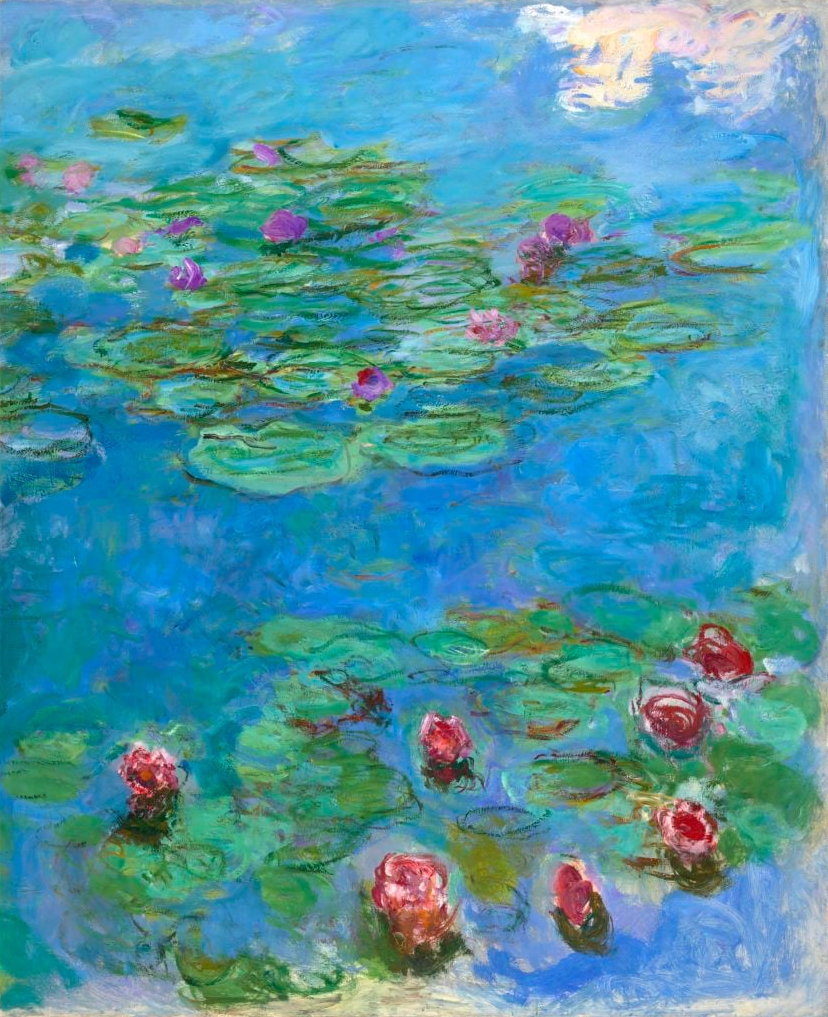Monet painted more than 250 paintings of water lilies.

Claude Monet, Water Lilies (1906), detail. Courtesy of the Art Institute of Chicago.
In 1914, Claude Monet was having a bad year. His beloved wife had died, cataracts clouded his vision, toothache dogged him, and Europe had plunged headlong into war. Soon, his son would be stationed on the frontline and his essential work staples—cigarettes and coal—grew scarce.
Monet retreated to his oasis in Giverny, a village 50 miles outside of Paris, and continued the Sisyphean task he’d been laboring under for much the preceding two decades: painting water lilies. It would be his final cycle, a colossal work with sunrise to sunset splashed across 300 feet of canvas. Following Monet’s death in 1926, Les Nymphéas would be donated to the French state and come to represent the final spasm of Impressionism.

Claude Monet, Nympheas: Sun Effects (1897). Musee Marmottan, Paris, France. Photo: VCG Wilson/Corbis via Getty Images.
Monet had purchased the two-story Giverny house in 1890 for 20,000 francs (roughly $130,000 today) with a loan from dealer Paul Durand-Ruel who had recently introduced the painter to the American market with great success. “I am in raptures,” Monet wrote his art-critic friend Théodore Duret. “Giverny is a wonderful place for me.”
Monet got to work, transforming the surrounding fruit orchard into the water garden with which he is now synonymous. Doing so required digging a basin and diverting the river Ru onto his property with the help of local laborers who nicknamed their stern taskmaster, “le marquis.” For the pond’s flora, Monet worked with a specialist nursery and imported hothouse cultivars from South America and Egypt.
Today, Monet’s flower garden is seen to evoke some bucolic ideal of the French countryside. In reality, it was pure artifice, a laboratory in which the artist carefully combined elements of English, French, Dutch, and Japanese horticultural traditions.
The last of these proved particularly informative. Peak Japonisme had arrived and Monet’s Giverny studio was filled with hundreds of Japanese prints. His attempts to emulate the composition of Utamaro and Hiroshige is evident in the arching footbridges he built across the ponds and, of course, the water lilies. Was Monet, as some have suggested, influenced by Buddhist thinking, finding in the water lilies’ ability to turn mud into beauty some painterly metaphor? It’s unclear. Monet was an atheist who found a certain zen in his garden—though his struggles painting it frequently led to fits of rage.
The garden’s most basic appeal was the control it offered Monet. For the preceding three decades, Monet had championed plein air painting, heading out into world to capture haystacks, hatted maidens, and hazy seascapes. Now, at Giverny, Monet brought the world to him.

Claude Monet, Water Lilies (ca. 1914-17). Fine Arts Museums of San Francisco. Courtesy of Kimbell Art Museum.
From 1890 to 1926, Monet would create more than 250 paintings of the water lilies. He had found his subject and there would be no need for another. Besides, as the artist said in an interview, “the water flowers are only an accompaniment.” The real subject was that fickle, forever fluid thing called light, which Monet said changed every seven minutes in Giverny.
This preoccupation with light intensified with age. Monet’s early water lilies feature fairly conventional components of landscape painting, such as careful framing and horizon lines. By 1909, Monet has shifted course radically, the viewpoint is tighter, the sky largely eliminated from the canvas and apparent only as a reflection, which “have become an obsession,” Monet told Gustave Geffroy.
His “Grande Decoration,” as Monet called his wall-to-wall paintings begun in 1914, went further still. He worked on them until his death, layering paint on top of paint in a series so blurred, mottled, and new it would in time be seen as a starting point for Jackson Pollock and Mark Rothko’s abstractions.
Written by Richard Whiddington
Source: Artnet







